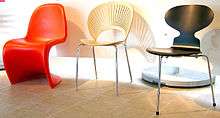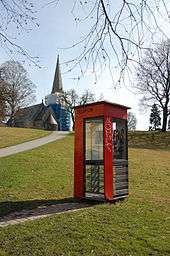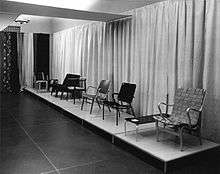Scandinavian design




Scandinavian design is a design movement characterized by simplicity, minimalism and functionality that emerged in the 1950s in the five Nordic countries of Finland, Norway, Sweden, Iceland and Denmark. While the term Scandinavia only refers to the three kingdoms of Denmark, Sweden and Norway, it can be used colloquially to refer to all five of these countries.
The Lunning Prize, awarded to outstanding Scandinavian designers between 1951 and 1970, was instrumental in both making Scandinavian design a recognized commodity, and in defining the profile of Scandinavian design. Since 2006, the tradition of a pan-Nordic design award has been resumed with the Forum AID Award.
The idea that beautiful and functional everyday objects should not only be affordable to the wealthy, but to all, is a core theme in the development of modernism and functionalism. This is probably most completely realized in post-WWII Scandinavian design. The ideological background was the emergence of a particular Scandinavian form of social democracy in the 1950s, as well as the increased availability of new low-cost materials and methods for mass production. Scandinavian design often makes use of form-pressed wood, plastics, anodized or enameled aluminum or pressed steel.
The concept of Scandinavian design has been the subject of many scholarly debates, exhibitions and marketing agendas since the 1950s. Many emphasize the democratic design ideals that were a central theme of the movement and are reflected in the rhetoric surrounding contemporary Scandinavian and international design. Others, however, have analyzed the reception of Scandinavian design abroad, seeing in it a form of myth-making and racial politics.[1]
Companies
Prominent Scandinavian design and retail companies include:
- Arabia – Finland[2]
- Bang & Olufsen – Denmark
- BoConcept – Denmark
- Design House Stockholm – Sweden
- Electrolux – Sweden
- Finlayson - Finland
- Georg Jensen – Denmark
- Iittala – Finland
- Ikea – Sweden
- Kvadrat – Denmark
- Louis Poulsen – Denmark
- Marimekko – Finland
- Orrefors – Sweden
- Royal Copenhagen – Denmark
- Stokke AS – Norway
- Søstrene Grene - Denmark
Scandinavian fashion companies include:
- Acne Studios – Sweden[3]
- Cheap Monday – Sweden
- ECCO – Denmark
- Filippa K – Sweden
- Finlayson - Finland
- H&M – Sweden
- Helly Hansen - Norway
- J. Lindeberg – Sweden
- Marimekko – Finland
- Moods of Norway - Norway
- Nudie Jeans – Sweden
Design in Denmark
Danish fashion stands as the fourth largest export out of all manufacturing industries in the country. Bringing in 30 billion dollars a year, fashion has become a catalyst in export, employment, and growth in Denmark. According to the Danish Fashion Institute, "Danish fashion companies have a higher shareholder value creation than any other fashion industry globally." The sixties and seventies were a period of growth of fashion in the country. From 1960–65 the clothing industry approximately doubled in size when its exports increased from 250 million to 500 million.
During this time, designers and manufacturers realized the need to focus on product development and knowledge of target area. Fashion shows became a growing phenomenon, and clothing was put into mass production by new Danish designers. While exports continued to increase, and fashion design in Denmark became more popular, designers began to promote their fashion worldwide in hopes to rival top fashion countries such as France and Italy. Because Danish fashion at the time was so distinctive, the media supported the new and fresh designs.
Design in Finland
Prominent Finnish designers include Alvar Aalto (vases, furniture), Aino Aalto (glassware), Kaj Frank (glass, tableware), Klaus Haapaniemi (fabric prints), Simo Heikkilä (furniture), Kristina Isola (textiles), Maija Isola (Marimekko prints), Harri Koskinen (glass, homeware), Mika Piirainen (clothing, accessories), Timo Sarpaneva (glass, homeware), Oiva Toikka (glass art), Tapio Wirkkala (glass art, glassware), Eero Aarnio (plastic furniture), Sanna Annukka (screenprints), Anu Penttinen (glass), Aino-Maija Metsola (textiles, homeware), and Maija Louekari (tableware, homeware).[4]
Design in Norway
Design in Sweden
References
- ↑ Leary, Erin, "'The Total Absence of Foreign Subjects': The Racial Politics of US Interwar Exhibitions of Scandinavian Design," Design and Culture 7:3 (2015): 283-312.
- ↑ "Ulla Procopé at Arabia from 1948-1966". Finnguide. 2008-01-21.
- ↑ "Jonny Johansson". Interview Magazine. 28 November 2008.
- ↑ "Finnish Designers". Finnish Design. Retrieved 7 May 2014. Information from pages on each artist on that website.
Books

- Bolander, Lars; MacIssac, Heather (2010), Lars Bolander's Scandinavian Design, Harry N Abrams.
- Englund, Magnus; Schmidt, Chrystina; Wood, Andrew (2007), Scandinavian Modern, Ryland Peters & Small.
- Fallan, Kjetil (2012), Scandinavian Design: Alternative Histories, Berg.
- Fiell, Charlotte J; Fiell, Peter (2005), Scandinavian Design, Taschen.
- Gura, Judith (2012), Sourcebook of Scandinavian Furniture, Designs for the 21st Century, Norton.
- Hard af Segerstad, Ulf (1961), Scandinavian Design (Nordisk Nyttokonst), Nordisk Rotogravyr.
- Halén, Widar; Wickman, Kerstin (2003), Scandinavian Design Beyond the Myth, Arvinius.
- Nelson, Katherine E; Cabra, Raul (2004), New Scandinavian Design, Chronicle Books.
- Oriol, Anja Llorella (2005), Asensio, Paco, ed., New Scandinavian Design, teNeues.
- Sommar, Ingrid (2005), Scandinavian Style, Carlton.
- Wickman, Kerstin (1996), Scandinavian Design: the dream is still alive, Swedish Information Service.
- Zahle, Erik (1961), A Treasury of Scandinavian Design, Golden Press.